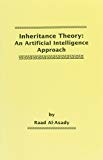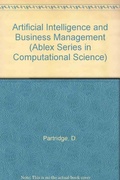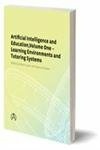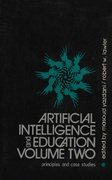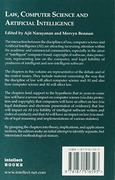Edition
1 Introduction 1
1.1 What is Intelligence? . . . . . . . . . . . . . . . . . . . . 1
1.2 Hierarchical Organization of Knowledge . . . . . . . . . . 3
1.2.1 Representation of Knowledge (Facts) Using Logic . . . . . . . . . . . . . 4
1.2.2 Representation of Knowledge Using Semantic Net-works . . . . . . . . . . . . . 5
1.3 Inheritance . . . . . . 6
2 Inheritance Hiercarchies . . . . . . . . . . . . . . 13
2.1 AI, Knowledge Representation and Inheritance. . . . . . . . . . . . . . 13
2.2 Inheritance Hierarchy Components Represented as Semantic Net-works. . . . . . . . . . . . . . 14
2.3 Inheritance Hierachical Structures. . . . . . . . . . . . . . 16
2.4 Exceptions . . . . . 85
2.4.1 Reduntant Links . . . . . . . . . . . . . . 23
2.4.2 Ambiguity. . . . . . . . . . . . . . 26
2.5 Mechanisms with Inheritance Structures. . . . . . . . . . . . . . 27
2.5.1 Directions of Path-Based Reasoning. . . . . . . . . . . . . . 35
2.6 Inheritance Formula As A Representation Language. . . . . . . . . . . . . . 38
3 Current Approaches to Nonmonotonic Reasoning. . . . . . . . . . . . . . 43
3.1 Introduction . . . . . . . . . . 43
3.2 Path-Based Review Literature . . . . . . . . . . . . . . 44
3.3 Logic-Based Approach. . . . . . . . . . . . . . 59
3.3.1 Monotonic Logic View. . . . . . . . . . . . . . 59
3.3.2 Nonmonotonic logic view. . . . . . . . . . . . . . 60
3.3.3 Modal Nonmonotonic Logic. . . . . . . . . . . . . . 60
3.3.4 Autoepistemic Logic. . . . . . . . . . . . . . 61
3.3.5 Default logic. . . . . . . . . . . . . . 62
3.3.6 Circumscription. . . . . . . . . . . . . . 66
3.3.7 Conditional logic. . . . . . . . . . . . . . 67
3.3.8 Probabilistic reasoning. . . . . . . . . . . . . . 68
3.3.9 Other Logical-Based Review Literature. . . . . . . . . . . . . . 70
3.4 Lattice-Based Approach. . . . . . . . . . . . . . 71
4 The Problem: A Clash of Intuitions. . . . . . . . . . . . . . 75
4.1 Introduction. . . . . . . . . . . . . . 75
4.2 Summary. . . . . . . . . . . . . . . 79
5 EIR: An Exception-Based Approach to Nonmonotonic Reasoning. . . . . . . . . . . . . . 81
5.1 Introduction . . . . . . . . . . . . . . 81
5.2 Exceptional Inheritance Reasoning. . . . . . . . . . . . . . 82
5.2.1 Typical and Exceptional Classes. . . . . . . . . . . . . . 82
5.2.2 Acquired and Inheritable Properties. . . . . . . . . . . . . . 84
5.3 The Exceptional Class. . . . . . . . . . . . . . 85
5.4 Conceptual Foundations of EIR. . . . . . . . . . . . . . 87
5.5 A Semi-formal Introduction to EIR. . . . . . . . . . . . . . 93
5.6 EIR Algorithm. . . . . . . . . . . . . . 97
5.7 Examples. . . . . . . . . . . . . . 100
5.7.1 The Royal Elephant Problem. . . . . . . . . . . . . . 100
5.7.2 Clyde, the Three.Legged.Thing. . . . . . . . . . . . . . 103
5. 7.3 The Tweety-Penguin Problem. . . . . . . . . . . . . . 106
5.7.4 The Unicorn Problem. . . . . . . . . . . . . . 109
5.8 The George Problem. . . . . . . . . . . . . . 113
5.8.1 On-Path ( or Acquired Properties) Versus Off-Path Revisited. . . . . . . . . . . . . . 114
5.9 The Generalization of EIR. . . . . . . . . . . . . . 116
5.10 Related Works. . . . . . . . . . . . . . 119
5.11 Conclusion. . . . . . . . . . . . . . 120
6 Default Correlation: An Approach to Inheritance With Conflict. . . . . . . . . . . . . . 123
6.1 Introduction. . . . . . . . . . . . . . 123
6.2 Inheritance. . . . . . . . . . . . . . 124
6.2.1 Ambiguity. . . . . . . . . . . . . . 125
6.2.2 Related Works . . . . . . . . . . . . . . 127
6.3 Ambiguity Revisited. . . . . . . . . . . . . . 128
6.3.1 Default Correlation Framework. . . . . . . . . . . . . . 133
6.3.2 Ambiguity Revisited with DC. . . . . . . . . . . . . . 136
6.4 Default Correlation Framework Algorithm. . . . . . . . . . . . . . 139
6.5 A Formal Description of the Representation Language. . . . . . . . . . . . . . 141
6.5.1 Example. . . . . . . . . . . . . . 141
6.6 Conclusion . . . . . . . . . . . . . . . . . 142
7 Application: Causal Reasoning and EIR. . . . . . . . . . . . . . 143
7.1 Introduction ........................143
7.2 Causal Reasoning: Artificial Intelligence Issues . . . . . . 145
7.3 Relation Between Inheritance Structures and Casual Structures . . . . . . . . . . . . . 147
7.4 Casuality and EIR . . . . . . . . . . . . . 151
7.4.1 Nonmonotnic Causation: EIR Explanation for Casual Structure . . . . . . . . . . . . . 151
7.4.2 A Semi-formal Introduction to Inheritance-Casual Relation . . . . . . . . . . . . . 156
7.5 Exceptional Inheritance-Casual Algorithm . . . . . . . . . . . . . 157
7.6 Script-Story Understanding . . . . . . . . . . . . . 157
8 Application: Analogical Reasoning and EIR . . . . . . . . . . . . . 165
8.1 Introduction . . . . . . . . . . . . . 165
8.2 The Role of Analogical Reasoning in AI . . . . . . . . . . . . . 166
8.3 Reviewed Literature . . . . . . . . . . . . . 167
8.4 Analogical Reasoning Revisited . . . . . . . . . . . . . 172
8.5 Analogical Inheritance Reasoning . . . . . . . . . . . . . 174
8.6 EIR and Analogical Reasoning . . . . . . . . . . . . . 177
9 Conclusion . . . . . . . . . . . . . 183
9.1 What has been Achieved . . . . . . . . . . . . . 183
9.2 Outstanding problems . . . . . . . . . . . . . 188


